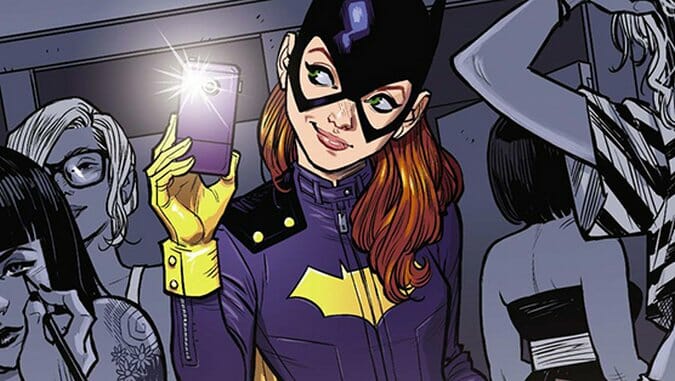Batgirl #35

Writers: Brenden Fletcher & Cameron Stewart
Artist: Babbs Tarr
Publisher: DC
Release Date: October 8, 2014
Batman wielded gadgets that make the iPhone 6 look like a typewriter in the ‘80s, and his coolness has perpetually transcended our pedestrian notions of youth and that which is hip. Batman doesn’t have to set up an Ello profile or casually mention that he’s majorly bummed about Crystal Castles breaking up in order to stay “relevant.” So why should Batgirl?
A few inspired moments in Batgirl #35 ought to give super fans of the character reason to expect better issues down the line from writers Cameron Stewart and Brenden Fletcher. The pair has concocted a promising premise, at least. Pulling Barbara Gordon out of the dour, ever-so-serious environs of Gotham proper to drop her into the breezy, bohemian borough of Burnside establishes a launching pad for earthly stories that might not work in A-list hero titles.
For example: one of the major antagonists in Matt Fraction’s acclaimed Hawkeye is the avenging archer’s scumbag landlord. We can believe Hawkeye has ordinary person problems because he’s much closer to being an ordinary person than his Norse god/preserved WWII strongman co-workers. On the other hand, Batman is a far cry from ordinary despite his lack of superpowers. When Darkseid sets up an anti-life bomb to murder all the kittens on Earth and Batman defuses the bomb and saves all the kittens, Batman is awesome — but the common folk can’t identify with him. His stakes are too high. The same goes for Superman and Wonder Woman.
However, in Batgirl #35, Batgirl (secret identity Barbara Gordon) overdraws her savings account, gets drunk and makes out with a stranger, and apologizes to her roommates on behalf of her impolite couch-surfing friend, Black Canary. She does the same kinds of things we do! And it’s believable for the same reasons as Hawkeye’s apartment building drama.
But that fact alone doesn’t instantly translate into a relatable comic. This issue reminds us that Barbara Gordon is a with-it early 20-something in 2014 on almost every damn page. The writers reference social media and mobile devises incessantly, characters vocally observe that Williamsburg Burnside is the “cool” part of town where the kids ride their fixie bikes to ubiquitous tattoo parlors and pretentious coffee shops, and additional cultural signifiers seep into every panel. In this over-saturated context, Batgirl comes off more like a stereotype of a 20-something than anything close to the genuine article.
For its part, Burnside resonates like a caricature of Brooklyn, and not the real Brooklyn, but the version of Brooklyn presented by Lena Dunham and Catey Shaw’s Brooklyn Girls; which makes Burnside a caricature of a caricature. It’s hard to tell if the writers are trying way too hard to appeal to millennials, or if they hate millennials and Batgirl is a scathing parody.
-

-

-

-

- Curated Home Page Articles By Test Admin October 21, 2025 | 3:10pm
-

- Curated Home Page Articles By Test Admin October 21, 2025 | 2:57pm
- Urls By Test Admin October 21, 2025 | 2:57pm
- Curated Home Page Articles By Test Admin October 21, 2025 | 2:55pm
-

-

-

-

-

-

-

-

-

-

-

-

-

-

-

-

-

-

-

-

-

-

-

-

-

-

-

-

-

-

-









































